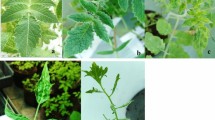Summary
A germplasm collection of 70 cultivars and wild species of Capsicum was evaluated for resistance to tomato spotted wilt virus (TSWV) under field (natural inoculum) conditions. Different levels of resistance to the disease caused by this virus were observed among the tested lines. High degree of field resistance was detected in two Capsicum baccatum var. pendulum, two C. chinense, and three C. annuum lines. Controlled greenhouse tests were also carried out to confirm the resistant reaction of these seven field selected lines. These lines were mechanically inoculated with two serologically distinct isolates of TSWV obtained from different geographic regions of Brazil. The two C. chinense lines (‘CNPH 275’ and ‘PI 159236’) were virtually immune against one specific (TSWV-BsB) isolate but were susceptible to another isolate (TSWV-SP) used in this assay. Sources of resistance for both isolates were not found. Our experimental results strongly indicate there exists a number of genetic mechanisms (probably including action of vertical and horizontal genes) to TSWV resistance in Capsicum spp.
Similar content being viewed by others
References
Black, L.L., H.A.Hobbs & J.M.GattiJr., 1991. Tomato spotted wilt virus resistance in Capsicum chinense PI 152225 and 159236. Plant Dis. 75: 863.
Boiteux, L.S. & L. de B.Giordano, 1992. Screening Lycopersicon germplasm for resistance to a Brazilian isolate of tomato spotted wilt virus (TSWV). TGC Report 42: 13–14.
Boiteux, L.S. & T.Nagata, 1993. Susceptibility of Capsicum chinense PI 159236 to tomato spotted wilt virus isolates in Brazil. Plant Dis. 77: 210.
Cho, J.J., R.F.L.Mau, T.L.German, R.W.Hartmann, L.S.Yudin, D.Gonsalves & R.Provvidenti, 1989. A multidisciplinary approach to management of tomato spotted wilt virus in Hawaii. Plant Dis. 73: 375–383.
Cupertino, F.P., M.T.Lin & J.O.Munoz, 1984. Perdas na produção do pimentão induzidas pelo virus de vira-cabeça do tomateiro. Fitopatol. bras. 9: 397.
Cupertino, F.P., F.J.B.Reifschneider & M.F.Batista, 1988. Avaliação de reação de populações de Capsicum aos virus Y da batata e vira-cabeça do tomateiro. Fitopatol. bras. 13: 148.
deÁvila, A.C., L.Peña, E.W.Kitajima, R. de O.Resende, M.V.Dias-Mugica, J.L.Dias Ruiz & D.Peters, 1991. Characterization of tomato spotted wilt virus isolated from Capsicum annuum L. in the Canarian Islands. Phytopathol. Mediterranea 30: 23–28.
Fraser, R.S.S., 1990. The genetics of resistance to plant viruses. Annu. Rev. Phytopathol. 28: 179–200.
Hibi, T. & Y.Saito, 1985. A dot immunobinding assay for the detection of tobacco mosaic virus in infected tissues. J. Gen. Virol. 66: 1191–1194.
Ie, T.S., 1970. Tomato spotted wilt virus. CMI/ABB Descriptions of Plant Viruses-No. 39.
Nagata, T., L.S.Boiteux, N.Iizuka & A.N.Dusi, 1992. Hospedeiros diferenciais e serologia na identificação de grupos do viracabeça do tomateiro em tomate e pimentão no Brasil. Fitopatol. bras. 17: 187.
Nelson, R.R., 1973. Breeding Plants for Disease Resistance-Concepts and Applications. Pennsylvania State University Press.
O'Malley, P.J. & R.W.Hartmann, 1989. Resistance to tomato spotted wilt virus in lettuce. HortScience 24: 360–362.
Paterson, R.G., S.J.Scott & R.C.Gergerich, 1989. Resistance in two Lycopersicon species to an Arkansas isolate of tomato spotted wilt virus. Euphytica 43: 173–178.
Reifschneider, F.J.B., L.S.Boiteux, P.T.Della Vecchia, J.M.Poulos & N.Kuroda, 1992. Inheritance of adult-plant resistance to Phytophthora capsici in pepper. Euphytica 62: 45–49.
Rice, D.J., T.L.German, R.F.L.Mau & F.M.Fujimoto, 1990. Dot blot detection of tomato spotted wilt virus RNA in plant and thrips tissues by cDNA clones. Plant Dis. 74: 274–276.
Robinson, R.A., 1976. Plant Pathosystems. Springer-Verlag, Berlin, Heidelberg, New York.
Stevens, M.R., S.J.Scott & R.C.Gergerich, 1992. Inheritance of a gene for resistance to tomato spotted wilt virus (TSWV) from Lycopersicon peruvianum Mill. Euphytica 59: 9–17.
Wang, M. & J.J.Cho, 1992. Identification of resistance to tomato spotted wilt virus in lettuce. Plant Dis. 76: 642.
Yuki, V.A. & A.S.Costa, 1985. Alta incidência de vira cabeça em tomate e pimentão nos meses de abril a agosto de 1984. Summa Phytopathol. 11: 50–52.
Author information
Authors and Affiliations
Rights and permissions
About this article
Cite this article
Boiteux, L.S., Nagata, T., Dutra, W.P. et al. Sources of resistance to tomato spotted wilt virus (TSWV) in cultivated and wild species of Capsicum . Euphytica 67, 89–94 (1993). https://doi.org/10.1007/BF00022729
Received:
Accepted:
Issue Date:
DOI: https://doi.org/10.1007/BF00022729




